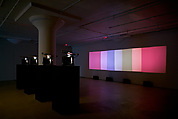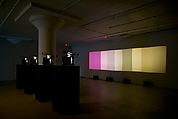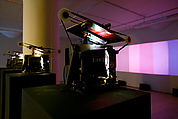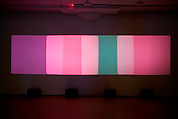Shutter Interface
Paul Sharits American
Not on view
A seminal figure in American avant-garde film Paul Sharits, who in the 1960s and 1970s along with a group of other filmmakers, became exponents of what critics P. Adams Sitney and Annette Michelson referred to as "structural film." Structural film was a film movement that was invested more in the technical basis and material components of film, rather than in narrative content and storytelling. Trained as a graphic artist and painter, Sharits became known for his 16 mm films that experimented with flicker and its perceptual impact and subsequently moved into immersive, spectacular film installations.
The artist stated in 1967, "I wish to abandon imitation and illusion and enter directly into the higher drama of: celluloid, two-dimensional strips; individual rectangular frames; the nature of sprockets and emulsion; projector operations; the three-dimensional light beam; environmental illumination; the two-dimensional reflective screen surface; the retinal screen, optic nerve and individual psycho-physical subjectivities of consciousness."
Sharits began making his film installations or "locational film pieces" in 1971. Shutter Interface, his fifth such environment completed in 1975, is comprised of four 16 mm projectors that are placed alongside each other with four soundtracks that run along the filmstrip played on a continuous loop emanating from four speakers. Each of the projectors project a single 6-minute 16 mm film of differing lengths onto a long black wall. Each film is comprised solely of sequences of pure, identical color varying between two to eight frames. The color frames are broken up by a single black frame, which introduces a persistent irregular pulsation into the field of vision. The plinths are positioned in such a way that a third of the projection overlaps with its neighboring loop. What is then seen on the wall are seven pulsating strips of color which are in flux, merging to create paler mixed hues and complicated patterns that seem to extend themselves endlessly. The installation casts a hypnotic and trancelike effect with its flickering and pulsating fields of color. The projected image invokes the CinemaScope format, but the foregrounded presence of the projectors dismantles that total enveloping cinematic illusion.
By relocating film from the cinema to the gallery or the museum, Sharits believed that these film installations were a way to bring work so intently focused on the cinematic apparatus to a non-specialist audience and generate an experience from it. The placement of a projector, now a more common place occurrence in contemporary galleries and art spaces, at the time was regarded as radical. With Shutter Interface and his other "locational film pieces," Sharits demanded of his audience to rethink an experience of cinema and to factor and consider the mechanisms of cinema. The works are also incredibly significant for their exploration of the relationship between color, material, and human perception.
Due to rights restrictions, this image cannot be enlarged, viewed at full screen, or downloaded.
This artwork is meant to be viewed from right to left. Scroll left to view more.






